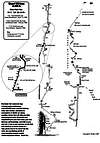-
 25787 Hits
25787 Hits
-
 74% Score
74% Score
-
 4 Votes
4 Votes
|
|
Route |
|---|---|
|
|
36.57860°N / 118.293°W |
|
|
Technical Rock Climb |
|
|
Most of a day |
|
|
IV or V, 5.10d |
|
|
History
Mt. Whitney has attracted the attention of technical climbers for many decades. In the summer of 1931, Dr. Robert Underhill, after instructing his companions in the use of proper roped belays, made the first ascent of the Regular East Face Route with Jules Eichorn, Glen Dawson and Norman Clyde. Twenty eight years later, after numerous unsuccessful attempts by various parties, Denis Rutovitz and Andrzel Ehrenfeucht established, in three days, what was for years to remain the most difficult climb on the highest peak in the Lower 48: The Direct East Face of Mt. Whitney.
Whereas the Regular Route avoids the major precipice of the face via an easy rising traverse up the Washboard, the Direct East Face confronts the lower thousand feet head-on. During the first ascent, Rutovitz and Ehrenfeucht encountered many pitches of difficult aid and free climbing up the obvious crack system in the center of the face. About halfway up the lower section, concerned about a possible night out on the small stances of the face, the pair discovered "the perfect bivouac cave"* deep in the cliff.
The following day, they were confronted with the crux of the route. Overhead was a large, black, damp overhang. Bolts and thin nailing were required to bypass a crack too wide for their gear. After several tied-off pitons, they pulled into a sandy alcove with easier chimneys above.
Eventually they reached the start of the Fresh Air Traverse, and after spending a second night out, continued up the Regular East Face Route to the summit.
In 1985 the Direct East Face was climbed in winter for the first time. More recently, it was climbed in a day, all free. Much of the route is rated 5.9 or easier, with one pitch of 5.10 offwidth, which most climbers still aid on fixed gear from previous scents.
Although many notable climbers have repeated the Direct, it has never seen the popularity of other Sierra classics. Perhaps the unsettling quality of the rock, or the possibility of stonefall from teams on the Regular Route have contributed to this. Nevertheless, the exposure, location and history of the Direct East Face of Mt. Whitney make for a memorable adventure.
Approach
Start from the Whitney Portal Trailhead. Follow the Mt. Whitney trail approximately 1 mile to where North Fork of Lone Pine Creek crosses the trail. Leave the trail and hike up Lone Pine Creek, following a climbers' trail through the willows first to climber's right of the creek, then to the left of the creek, about 1/2 mile. Shortly after crossing back to the right side of the creek, climb up the right wall of the canyon 2nd-3rd class to Ebersbacher Ledges. Head left (upcanyon) on the ledges and continue upstream to Lower Boy Scout Lake. Continue up the canyon, just to the left of the waterfalls and brush at the head of Lower Boy Scout Lake. Above the falls, work up and right on slabs, aiming for a distinct cluster of conifers on the canyon floor below upper Boy Scout Lake. This is Clyde Meadow. Head due south up talus slopes. At the top of the talus field continue up the drainage, passing the base of the small cliffs that lead to Iceberg Lake. Continue up the cirque to the base of the main east face of Whitney, where the Great Book, Hairline, and Direct East Face are located.
Route Description
See topo.
In each of the attached photos, the black water streaks at the start of the route are clearly visible. The Direct East Face is the obvious chimney system starting just to the right of the streaks.
This route repulsed numerous attempts throughout the 1950s. Perhaps the most direct and obvious line up the East Face proper, it requires good routefinding skills, a wide repertoir of climbing techniques, and perhaps most importantly, a sense of adventure not applied in repeating many of the Sierra's more well-travelled routes.
Seldom attempted, it is nevertheless a "must-do" for those who have tired of the more popular (and usually easier) routes in the Sierra.
Enjoy, for this is one of the Sierra's hidden treasures on its most popular peak.
Essential Gear
See topo. Cams to 7" are useful if freeing the 5.10d offwidth.
References
* Secor, R.J.. The High Sierra: Peaks, Passes and Trails.
p 73 (2nd edition)
Roper, Steve. The Climber's Guide to the High Sierra.
pp 308 (descent), 309 (route description)
Wheelock and Condon. Climbing Mt. Whitney. La Siesta Press, 1960.
p 29 (Ebersbacher Ledges Approach)
American Alpine Club. American Alpine Journal. 1993.
pp 150-151
Maps:
United States Geological Survey Quadrangles-- Mt. Whitney (15-minute)
Mt. Langley (7.5 minute), and Mt. Whitney (7.5 minute)





